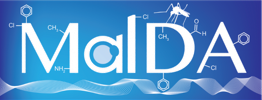Validation of isoleucine utilization targets in Plasmodium falciparum.
Journal:
Proceedings of the National Academy of Sciences of the United States of America, Volume: 108, Issue: 4Abstract:
Intraerythrocytic malaria parasites can obtain nearly their entire amino acid requirement by degrading host cell hemoglobin. The sole exception is isoleucine, which is not present in adult human hemoglobin and must be obtained exogenously. We evaluated two compounds for their potential to interfere with isoleucine utilization. Mupirocin, a clinically used antibacterial, kills Plasmodium falciparum parasites at nanomolar concentrations. Thiaisoleucine, an isoleucine analog, also has antimalarial activity. To identify targets of the two compounds, we selected parasites resistant to either mupirocin or thiaisoleucine. Mutants were analyzed by genome-wide high-density tiling microarrays, DNA sequencing, and copy number variation analysis. The genomes of three independent mupirocin-resistant parasite clones had all acquired either amplifications encompassing or SNPs within the chromosomally encoded organellar (apicoplast) isoleucyl-tRNA synthetase. Thiaisoleucine-resistant parasites had a mutation in the cytoplasmic isoleucyl-tRNA synthetase. The role of this mutation in thiaisoleucine resistance was confirmed by allelic replacement. This approach is generally useful for elucidation of new targets in P. falciparum. Our study shows that isoleucine utilization is an essential pathway that can be targeted for antimalarial drug development.
